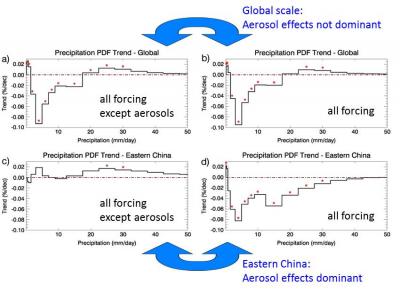Reconciling the Influence of Aerosols and Greenhouse Gas Emissions on Precipitation Changes
Precipitation intensity has been changing over the last century. Our analysis suggests that aerosols are primarily responsible for the suppression of light precipitation in Eastern China, while greenhouse gases mainly explain the changes in precipitation intensity on the global scale.
The attribution of the observed shift in precipitation extremes to different forcing agents is a critical issue for understanding changes in the hydrological cycle. This quantifies the relative importance of greenhouse gases and aerosols in regulating the precipitation trends over the last 50 years in China and over the whole globe.
Researchers, including scientists at Pacific Northwest National Laboratory, used the Community Atmosphere Model version 5.3 (CAM5) model to simulate precipitation changes from 1950 to 2005 with and without anthropogenic aerosol forcings. They employed precipitation rates at every model time step in CAM5 to construct precipitation intensity probability distribution functions. They found that the accumulation of greenhouse gases is responsible for the shifts in precipitation intensity on the global scale. However, in Eastern China, dramatic increases in anthropogenic aerosol particles appear to account for most of the observed light precipitation suppression since 1950s. In a warming climate induced by increasing greenhouse gases, the simulations suggest that in the tropics, enhanced ascending motions primarily lead to shifts in the distribution of precipitation, with decreases in light precipitation and increases in moderate and heavy precipitation. However, there is no significant change in ascending motions in Eastern China from greenhouse gas forcing. The analysis suggests that in Eastern China aerosol particles modify cloud microphysical properties and warm rain processes, and dominate over the aerosol radiative effects which act to decrease light precipitation.

